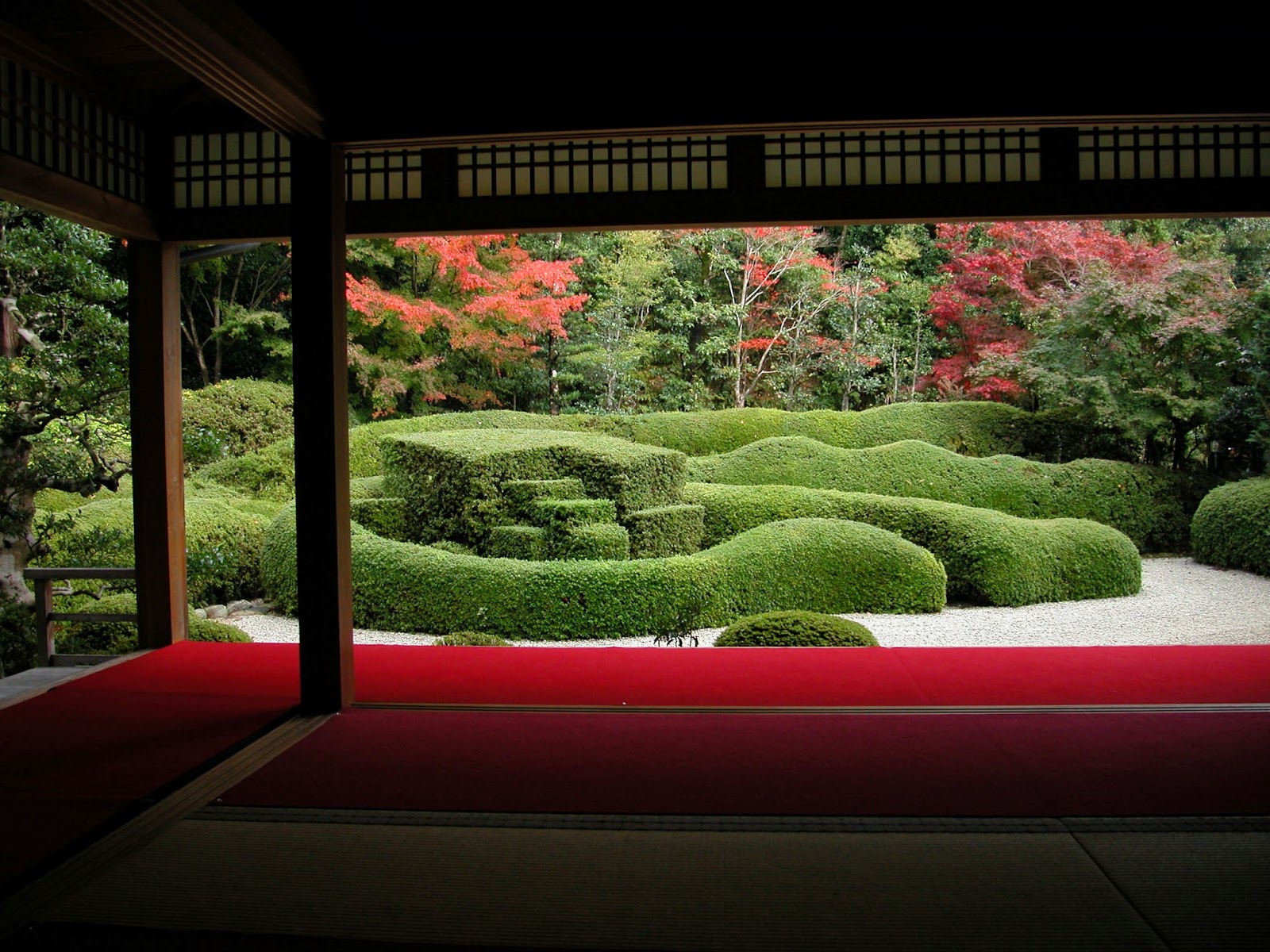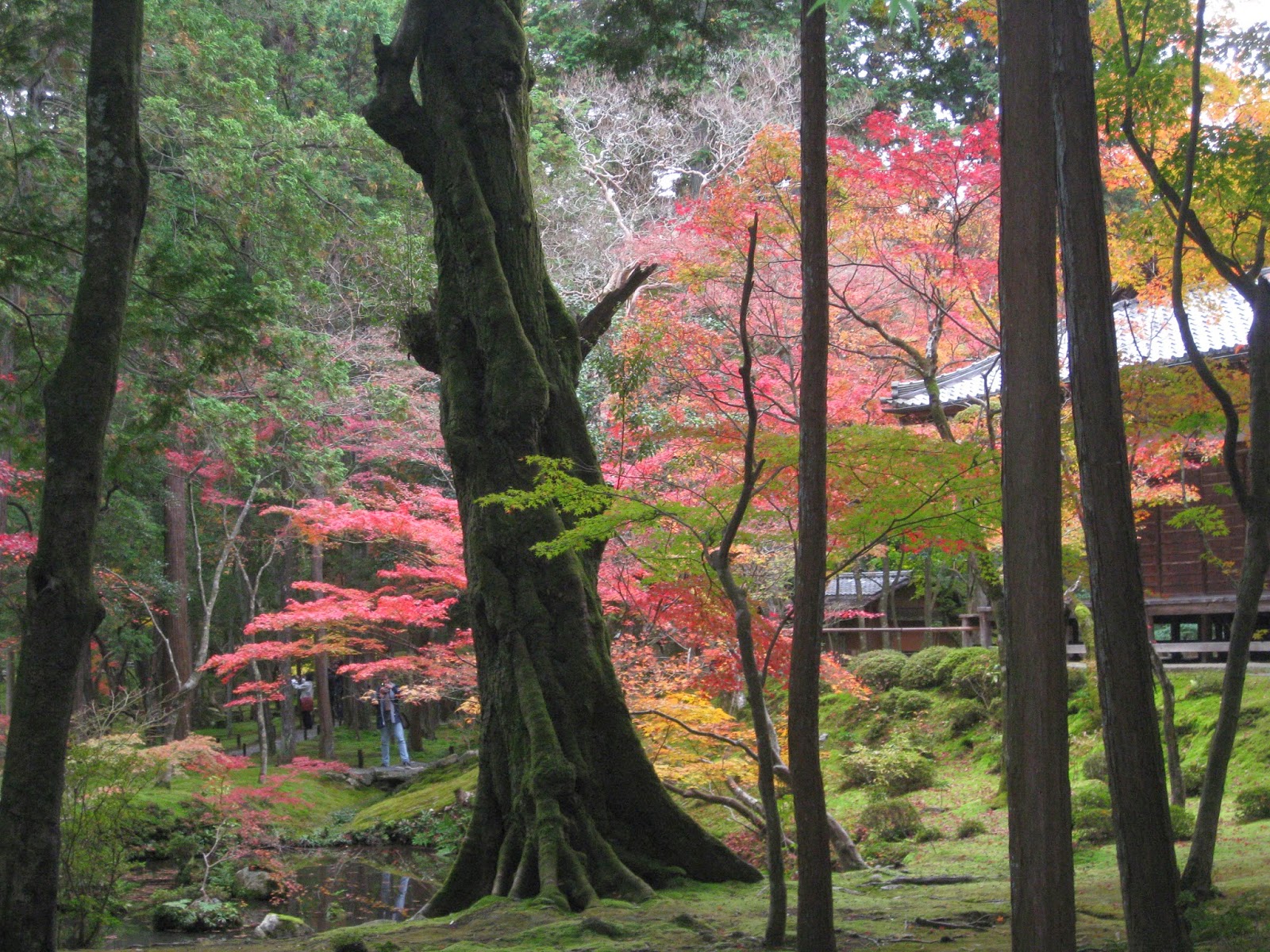There are broadly four different types of garden that are
found in Japan, though it should be noted that these are not necessarily
exclusive to one another. It is often the case that within the precincts of an
institution, residence or temple more than one type of garden may be found.
Also, that some gardens may contain a mixture or blend of elements from
differing styles. In other words there are no rigid rules, as the garden
creators felt free to delve into the richness of the garden tradition when
drawing upon inspiration.
 |
| Shugaku Rikyu |
This is the ‘oldest’ type of garden to be found in Japan,
and it has its origins in the very earliest gardens that were created there.
The original conception of garden creation was to create an environment that
would tempt the deities down from heaven to dwell in proximity to human beings.
These are gardens that were created to be both visually accessed from the
interior of buildings, as well as to be seen whilst walking around them. Dependant
on the area available to be developed as a garden, these gardens can cover
several acres and the pond was often made large enough to accommodate boating
excursions (a popular activity particularly in the 10th and 11th
centuries).
 |
| Katsura Rikyu |
As with nearly all Japanese gardens the layout of the
gardens attempted to evoke the sense of being complete landscapes, hence they
were also known as tsukiyama niwa
(‘man-made hill’ gardens), as they would feature areas of raised ground
depicting mountains or hills. In many gardens it was fashionable to recreate
well-known beauty spots, both within Japan and also from China too. These would
be known to the educated classes from sources such as poetry, also the symbolic
representation of far distant landscape scenery allowed the visitor greater
freedom to travel imaginatively whilst touring the garden. The gardens were
often laid out in accordance with geomantic considerations, which governed, for
example, the orientation of water inlets and outlets, as well as features such
as important stone arrangements.
This garden style also featured in Jodo (‘Pureland’) temple
gardens (11thC and 12thC AD) where the garden was a
deliberate attempt to create a paradisial world separated from the cares and
concerns of the world of man. A surviving example of this is the famous Moss
Temple garden at Saiho-ji.
 |
Saiho-ji
|
Dry Landscape style Gardens
 |
| Manshu-in |
The karesansui garden
was a development that is most often associated with the sophisticated culture
of Zen Buddhist temples. The particular characteristic of these gardens is the
intimation of the presence of water, which is usually suggested by gravel raked
in long, flowing, fluvial lines. The content of these gardens varies from the
absolute simplicity of Ryoan-ji (Kyoto) to such highly complex rock arrangements
such as at Daisen-in temple, Kyoto. The karesansui style probably developed from the Chinese practice
of creating trayscapes, which featured small stones and sometimes, penjing (bonsai), arranged in flat dishes, which would be
set on a table to be admired. The profound simplicity and discipline of these
gardens, offers the garden creator immense scope to improvise.
The principal gardens that are created in Zen temples,
occupy a position to the south of the main building. These courtyard spaces are
usually surrounded by clay walls, and within these spaces the arrangement of
sometimes large stones may be set to give a stirring sense of visual drama,
counter-balanced by flat open areas of raked gravel or ‘empty’ spaces. The
arrangements themselves are frequently symbolic depictions of images intended
to arouse the notion (and awareness?) of paradise (nirvana) in the viewer, such as turtles, cranes and the
mystic isle Mt. Horai. In other words the gardens are intended to communicate
directly with the viewer.
 |
| Seigan-ji |
The karesansui style
of garden is probably the most widely imitated style of garden outside of
Japan, and has laterly become synonymous with the term ‘Zen garden’. Its pared
back, sparse style allied to a powerful visual expression, makes it appear
simple to imitate. Though most versions found outside of Japan, and several
within, only prove the depth of subtlety at play in these most enigmatic of
gardens.
 |
| Koto-in |
What we understand as Tea gardens today begin to appear in
the 16th C, under the influence of Tea masters such as Sen no Rikyu,
Furuta Oribe. Essentially the Tea garden is a path that transits between the
world of everyday affairs with the teahouse interior. Also known as Roji, or ‘the Dewy Path’. The whole ambiance of the garden
is intended to evoke the sense of a path in the mountains, the teahouse a
‘simple’ rustic dwelling. This image of rustic simplicity, and by extension an
implication of spiritual contentment, goes to the heart of aesthetic ideals in
the East. From China, Japan absorbed the notion of Nature (in particular remote
mountains) being a location where spiritual enlightenment can take place.
Indeed the very image of the remote rustic retreat can be read as a metaphor
for spiritual development and achievement, for it was to the mountains that the
sages retired to search for just that knowledge and illumination. Much as early
Western Christian mystics turned toward nature to seek a place of
contemplation.
 |
| Genkuen |
The garden is often divided into two parts, the ‘outer’ and
‘inner’, a division being made by a simple bamboo gateway. The two parts of the
garden are notional, which adds a sense of transition to the progression. The
visitor moves through the garden space by traversing a stepping stone path. The
principal visual features of the garden being a stone lantern and a water basin
arrangement. Stone arrangements are relatively few, and determinedly low key;
the planting a selection of primarily evergreen planting, and the principal
groundcover being a carpet of verdant mosses. Everything in the garden is
intended to calm the senses, rather than creating a sense of visual excitement
or drama. The form and manner of the roji
was to become another constituent element feeding into the overall garden
tradition.
 |
| Shimabara |
Tsubo niwa are the
relatively small spaces found between buildings that are developed as garden
areas. These are gardens that were to be found scattered among the residences
of the aristocracy, in temples, as well as in the more secular settings of merchants’
houses. If there is a continuity of character in these gardens it is that they
do not fit easily in any particular tightly defined category. Rather it is as
if they appear as ‘fragments’ of gardens, which nevertheless are capable of
standing alone in their own right. Thus a garden may feature a solitary
planting of banana trees (a plant much appreciated for the sound raindrops make
falling on the broad leaves); whilst another space may simply contain an
ancient stone lantern, or a rustic water basin.
In the context of the architectural arrangement these spaces
offered an important function of creating an opening to the sky, allowing light
and air to circulate. It should be borne in mind that architectural interiors
were often dark, gloomy, spaces, in part because of the wide overhanging eaves
that extended the roof well beyond the walls to cover the wooden walkways
(verandas) that usually surrounded the buildings. Therefore a tsubo niwa would provide a vibrant connection with open space,
as well as having the function of drawing nature into close contact with the
lives of the people occupying the interiors.
 |
| Ryogen-in |
To follow this blog:
the 'Follow by E-mail' facility is now operating.
Don't miss a beat and sign in.



































